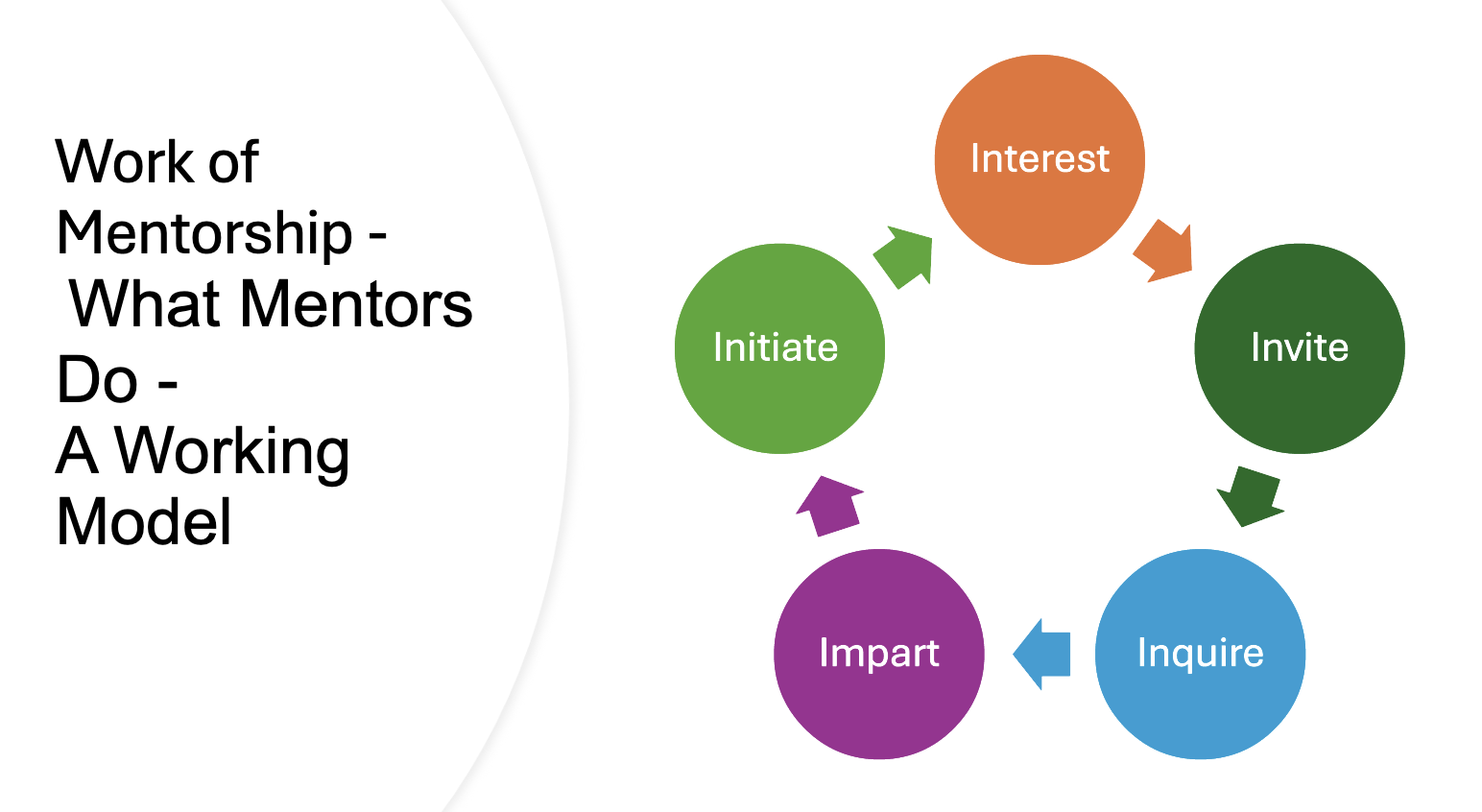As we transition from understanding why mentorship matters and why it often fails to the practical work of mentorship, we arrive at a crucial question: Where do I begin? Whether you're Sarah meeting Professor Thompson for the first time, or Emily preparing to guide someone like Sarah, the foundation of effective mentorship lies in understanding what mentors actually do.
The stories we've explored—from Sarah's journey with Professor Thompson to Marcus's wall of fifty names—reveal a pattern in transformative mentoring relationships. These relationships don't happen by accident, nor do they flourish through good intentions alone. They develop through intentional actions that build trust, foster connection, and create space for meaningful growth. This is where our working model becomes essential: Interest, Invite, Inquire, Impart, Initiate.
This five-part framework isn't merely a checklist to complete in a single coffee meeting. Instead, it represents a progressive deepening of the mentoring relationship—a roadmap for moving from surface-level interaction to profound, life-changing connection. Each element builds upon the previous one, creating a foundation strong enough to support the weight of authentic vulnerability and transformative growth.
Interest: The Foundation of Authentic Connection
Every meaningful mentoring relationship begins with genuine interest—not the polite curiosity we might show a stranger, but the authentic care that says, "Your story matters to me." This was evident when Professor Thompson first met Sarah. She didn't simply ask about Sarah's academic performance; she invested time in understanding Sarah's fears, aspirations, and the deeper currents flowing beneath her surface concerns.
Interest manifests in multiple ways: remembering details from previous conversations, asking follow-up questions that demonstrate you've been listening, and showing curiosity about aspects of their life beyond the immediate challenge they're facing. When we show genuine interest, we communicate value—that this person is worth knowing, not just helping.
Yet many potential mentors struggle here. Some are naturally task-oriented, eager to jump to problem-solving without first establishing the relational foundation. Others may feel uncomfortable with personal disclosure, preferring to keep relationships at arm's length. The mentor's self-awareness becomes critical: Are you naturally inclined toward interest, or is this an area requiring intentional growth?
The depth of your interest often determines the ceiling of your mentoring impact. Without genuine care for the whole person, mentorship becomes mere advice-giving or professional networking. With authentic interest, it becomes the soil in which transformation takes root.
Invite: Creating Space for Vulnerability
Interest leads naturally to invitation—not just the invitation to meet for coffee, but the ongoing invitation to enter into meaningful conversation about what truly matters. This is where many mentoring relationships either flourish or falter. The invitation must feel safe, genuine, and unhurried.
Consider Emily's approach with Sarah. She didn't immediately probe for Sarah's deepest struggles or launch into her own success stories. Instead, she created an atmosphere where Sarah felt invited to share authentically. This might mean asking open-ended questions, sharing something vulnerable about your own journey first, or simply creating space in your schedule that doesn't feel rushed or perfunctory.
The art of invitation requires sensitivity to timing and context. Tom Stanley's sad reality—"I have no one to call"—reminds us that many people have been hurt by relationships that felt extractive rather than generous. Your invitation must feel like a gift, not an obligation. It should communicate: "I'm here, and there's space for whatever you need to share."
Some mentors excel at showing interest but struggle with invitation. They may care deeply but lack the skills or confidence to create the emotional safety required for deeper sharing. Others may extend invitations freely but without the foundational interest that makes those invitations feel authentic. The progression matters: genuine interest must precede meaningful invitation.
Inquire: The Art of Discovery
Once space has been created through interest and invitation, the skill of inquiry becomes paramount. This goes far beyond asking good questions—though that's certainly part of it. Inquiry represents a posture of curiosity that seeks to understand not just what happened, but why it matters, how it felt, and what it reveals about the person's deeper story.
Professor Thompson's approach with Sarah exemplified this principle. She didn't simply ask about Sarah's career plans; she inquired about Sarah's fears, her dreams, her past experiences that shaped her current uncertainties. She used questions as tools for discovery rather than just information gathering.
Effective inquiry requires the three practices of understanding we explored through Mia's story: active listening, empathetic communication, and acknowledgment and validation. It means resisting the "hammer and nail" mentality—the urge to fix problems before fully understanding them. Instead, inquiry creates space for the mentee to explore their own thoughts and feelings, often discovering insights they didn't know they possessed.
The progression from invitation to inquiry is delicate. You can't rush to deeper questions without first establishing safety through interest and invitation. Yet without skillful inquiry, the relationship may plateau at surface-level pleasantries. The mentor's growth often lies in learning to ask better questions—questions that open doors rather than close them, that invite exploration rather than demand answers.
Impart: Sharing Wisdom with Timing and Grace
After establishing interest, extending invitation, and engaging in genuine inquiry, the mentor earns the right to impart wisdom. This is often what people think mentorship is primarily about—the sharing of knowledge, insights, and hard-earned life lessons. Yet without the foundation of the first three elements, even the wisest counsel falls on deaf ears or creates resistance.
Marcus understood this principle. His wall of fifty names represented decades of accumulated wisdom, but his effectiveness as a mentor didn't come from simply downloading that information to his mentees. Instead, he learned to share his insights at the right moments, in the right ways, when his mentees were ready to receive them.
Imparting wisdom effectively requires several skills: discernment about timing, the ability to share stories and principles that connect to the mentee's specific situation, and the humility to recognize that your path may not be their path. It means moving beyond generic advice to personalized guidance that honors the unique person sitting across from you.
Some mentors are natural wisdom-sharers but struggle with the earlier elements of the model. They may have vast knowledge to impart but lack the relational foundation that makes sharing meaningful. Others may excel at interest and inquiry but hesitate to share their own insights, leaving mentees hungry for the wisdom that experience has provided. The balance requires both confidence in your insights and humility about their limitations.
Initiate: Launching into Action and Growth
The final element of the model—initiate—represents the transition from understanding to action, from insight to implementation. This is where the mentor helps the mentee move from conversation to change, from awareness to growth. It might involve challenging conversations, accountability structures, or simply the encouragement needed to take the next step.
Emily's relationship with Sarah demonstrated this beautifully. She didn't just listen to Sarah's concerns about self-advocacy and career development; she initiated specific conversations about training opportunities, introduced her to valuable connections, and challenged her to step boldly into unknown territory. The initiation was natural, growing out of their established relationship rather than being imposed from outside.
Initiation often reveals the mentor's own growth edges. Some mentors are comfortable with empathy and understanding but struggle to challenge their mentees toward growth. They may prefer to remain in the "safe" territory of emotional support rather than risk the discomfort of difficult conversations. Others may be quick to initiate action but without the foundation of trust and understanding that makes such challenges welcome rather than threatening.
The Progressive Deepening
This five-element model functions as both a framework for individual meetings and a progression for the overall relationship. In a single conversation, you might move through all five elements naturally—showing interest in how they're doing, inviting them to share what's really on their mind, inquiring about the deeper issues, imparting relevant wisdom, and initiating next steps. Over time, each element deepens and matures as trust builds and understanding grows.
The key lies in the mentor's self-awareness and intentional growth. Where are you naturally strong? Where do you need to develop? A mentor who excels at interest and invitation but struggles with inquiry may create warm but ultimately superficial relationships. One who is quick to impart and initiate but weak in the foundational elements may find their wisdom rejected or resented.
The model also serves as a diagnostic tool for relationships that feel stuck. If a mentoring relationship lacks depth, which element might be missing? If it feels one-sided or superficial, where might greater intentionality be needed?
Beyond the Single Coffee Meeting
Perhaps most importantly, this model elevates mentorship beyond the casual coffee meeting or occasional check-in. It provides a framework for sustained, intentional relationship-building that can transform both mentor and mentee. When all five elements are present and functioning, the significance and impact of the mentorship naturally follow.
The progression from interest to initiation mirrors the journey from disconnection to authentic relationship, from isolation to belonging, from uncertainty to confident action. It addresses the epidemic of loneliness we've explored by creating genuine human connection. It combats the threats to meaningful relationship by establishing something deeper than digital interaction or superficial networking.
As you prepare for your next mentoring conversation—whether as a first-time mentor or an experienced guide—consider this model not as a rigid structure but as a living framework. Let it remind you that effective mentorship is both art and skill, requiring both heart and intentionality. Most importantly, let it guide you toward the kind of relationship that transforms not just the mentee, but the mentor as well.
The stories of Sarah and Professor Thompson, Emily's perspective, Marcus's wall of names—all point toward the same truth: meaningful mentorship happens when we show up with interest, create space through invitation, discover deeply through inquiry, share wisely through imparting, and launch boldly through initiation. When these elements align, we create the conditions for the kind of transformative relationship that our disconnected world desperately needs.

